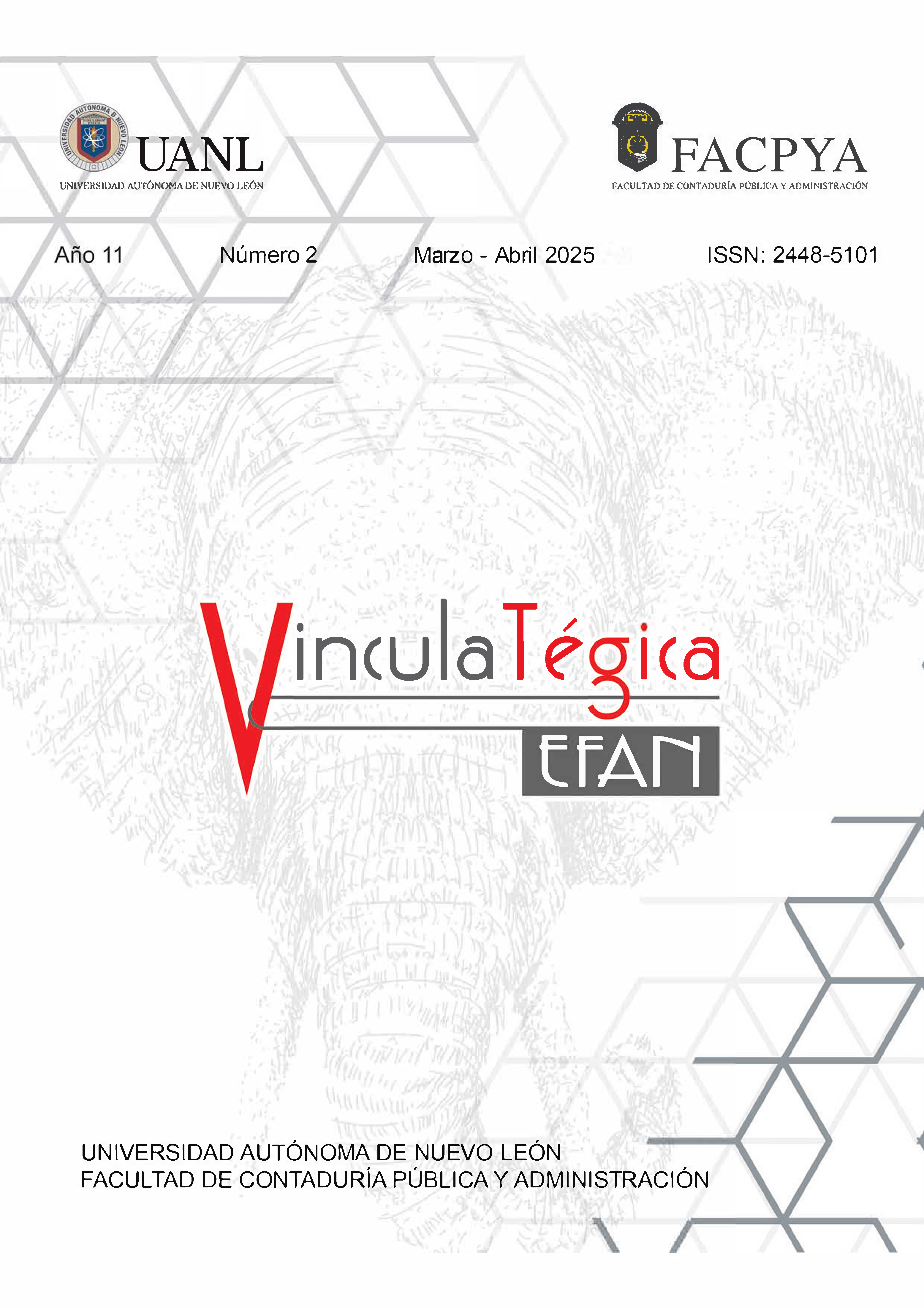Influence of the dimensions of work commitment on the staff of the millennial and centennial generations
DOI:
https://doi.org/10.29105/vtga11.2-1040Keywords:
Work commitment, affective commitment, continuous commitment, normative commitment, millennial and centennial generationsAbstract
Nowadays, it is important for organizations to achieve a competitive advantage. In the field of human resources, this is achieved with the retention of talent, which is achieved if the staff is committed. Therefore, companies seek to increase the work commitment of their employees. people, well, this ensures compliance with organizational objectives. The objective of this research is to determine if there are significant differences in the influence of the dimensions of work commitment in the staff of the millennial and centennial generations of the Monterrey Metropolitan Area. This quantitative and descriptive study is cross-sectional, non-experimental and non-probabilistic, since the surveys were applied at random. 202 people from the millennial generation between 29 and 49 years old were surveyed and people from the centennial generation between 22 and 28 years old, a survey with a Likert-type scale response was used. An Anova was carried out and the results obtained show that there is no significant difference in work commitment and its dimensions, affective, continuous and normative commitment.
Downloads
References
Akhtar,A., Ali, M., Khokhar, M., Haneef, M., Scholar, M., y Ali, A. (2023). The Impact of Gold, Oil Prices, and their Associated Implied Volatilities on Performance of Pakistan’s Stock Market. Pakistan. Journal of Humanities and Social Sciences, 11(2), 1371–1384. https://journals.internationalrasd.org/index.php/pjhss/article/view/1203 DOI: https://doi.org/10.52131/pjhss.2023.1102.0441
Araque. J., Sánchez, J. y Uribe, R. (2017). Relación entre marketing interno y compromiso organizacional en Centros de Desarrollo Tecnológico colombianos. Estudios Gerenciales, 33(142) 95-101. http://www.scielo.org.co/scielo.php?script=sci_arttext&pid=S0123-59232017000100095 DOI: https://doi.org/10.1016/j.estger.2016.12.005
Asrar, M., Kuchinke, K. y Iqbal, A. (2017). The relations hipbetweencorporate social responsibility, jobsatisfaction, and organizational commitment: Case of Pakistanihigher education. Journal of Cleaner Production, 142(4), 2352-2363. https://www.researchgate.net/publication/309894485_The_relationship_between_corporate_social_responsibility_job_satisfaction_and_organizational_commitment_Case_of_Pakistani_higher_education DOI: https://doi.org/10.1016/j.jclepro.2016.11.040
Baez, R., Zayas, P., Velázquez, R., y Lao, R. (2019). Modelo conceptual del compromiso organizacional en empresas cubanas. Ingeniería Industrial, XL (1), 14-23. https://www.redalyc.org/journal/3604/360458834003/html/#B8
Becker, H. (1960). Notes onthe concept of Commitment. American Journal of Sociology, 66(1), 32-40. https://www.jstor.org/stable/2773219 DOI: https://doi.org/10.1086/222820
Betanzos, N., Andrade, P. (2006). Compromiso organizacional en una muestra de trabajadores mexicanos. Revista de Psicología del Trabajo y de las Organizaciones, 22(1), 25-43. https://journals.copmadrid.org/jwop/files/100434.pdf
Bozat, Z. A. (2021). Differences between Generation Y and YZ in Accordance with Organisational Commitment. İşletme Akademisi Dergisi, 2(4), 350-366. https://www.researchgate.net/publication/357452096_Differences_between_Generation_X_and_Y_in_Accordance_with_Organisational_Commitment DOI: https://doi.org/10.26677/TR1010.2021.912
Coronado, G.,Valdivia, M., Aguilera, A., Alvarado, A. (2020). Compromiso Organizacional: Antecedentes y Consecuencias. Conciencia Tecnológica, 60(1), 1-20. https://www.redalyc.org/articulo.oa?id=94465715006
Drew. (2022). ¿Cómo trabajar la ausencia de compromiso en la generación z? Wearedrew.co; Drew. https://blog.wearedrew.co/liderazgo/como-trabajar-la-ausencia-de-compromiso-en-la-generacion-z
Esparza-Montes, A. C., & Segovia-Romo, A. (2019). Factores que inciden en la intención de permanencia de los empleados en una institución educativa. Vinculatégica EFAN, 5(2), 1127–1138 https://vinculategica.uanl.mx/index.php/v/article/view/731 DOI: https://doi.org/10.29105/vtga5.2-731
Galván, C. y Silva, M. (2021). La Diversidad Generacional sobre el Compromiso Organizacional del Personal Docente de una IES. Conciencia ecológica, 62(1), 1-20. https://www.redalyc.org/journal/944/94469878005/html/
Gerards, R., de Grip, A., y Baudewijns, C. (2018). Do new ways of working increase work engagement? Personnel Review, 47(2), 517-534. https://cris.maastrichtuniversity.nl/files/35326159/Grip_2018_Do_new_ways_of_working.pdf
Mendoza, M., y Ortiz, R. (2006). El liderazgo transformacional, dimensiones e impacto en la cultura organizacional y eficacia de las empresas. Revista Facultad de Ciencias Económicas: Investigación y reflexión, XIV (1), 118-134. https://www.redalyc.org/pdf/909/90900107.pdf
Meyer, J y Allen, N (1991). A three-compoonent conceptualization of organizational commitment. Human Resource Management Review, 1(1), 61-89. https://www.sciencedirect.com/science/article/abs/pii/105348229190011Z DOI: https://doi.org/10.1016/1053-4822(91)90011-Z
Ortega, I., y Vilanova, N. (2016). Generación Z: El último salto generacional. Atrevia y Deusto Business School. https://revistabyte.es/actualidad-byte/generacion-z-el-ultimo-salto-generacional/.
Pedraza, N. (2020). Satisfacción laboral y compromiso organizacional del capital humano en el desempeño en instituciones de educación superior. RIDE Revista Iberoamericana para la Investigación y el Desarrollo Educativo, 19(20), 51-60. https://www.researchgate.net/publication/345037643_Satisfaccion_laboral_y_compromiso_organizacional_del_capital_humano_en_el_desempeno_en_instituciones_de_educacion_superior
Peimbert, E. (2012) La Generación “Y” o “Millennials.” Konzeppt, Marketing Interactivo
Placeres-Salinas, S. I., Araiza-Vázquez, M. de J., & Torres-Mansur, S. M. (2022). El compromiso organizacional un factor clave para la innovación en las Organizaciones . Vinculatégica EFAN, 8(2), 153–164. https://vinculategica.uanl.mx/index.php/v/article/view/341 DOI: https://doi.org/10.29105/vtga8.2-341
Pontón, E., y Márquez, C. (2016). El marketing como base para el emprendimiento de los millenials. En Palermo Business Review, 65-82. https://www.palermo.edu/economicas/cbrs/pdf/pbr14/PBR_14_05.pdf
Porter y Lawler (1965) Propertiesof organization structure in relation to job attitudes and job behavior. Psychological Bulletin, 64(1), 23-51. https://psycnet.apa.org/record/1965-13133-001 DOI: https://doi.org/10.1037/h0022166
Rahman, M., Som, H.,Karim, N. (2023). The effect of pay equity on organizational commitment in higher education institutions in Bangladesh. Problems and Perspectives in Management, 21(4), 240-252. https://www.businessperspectives.org/index.php/journals/problems-and-perspectives-in-management/issue-442/the-effect-of-pay-equity-on-organizational-commitment-in-higher-education-institutions-in-bangladesh DOI: https://doi.org/10.21511/ppm.21(4).2023.19
Robles Ortiz, A.M y Romero Paredes, P.V. El compromiso organizacional de la generación Millennial y la generación Z en la cooperativa de ahorro y crédito Credi Ya LTDA [Tésis de Licenciatura, Universidad Técnica de Cotopaxi]. https://repositorio.utc.edu.ec/bitstream/27000/11929/1/PI-002679.pdf
Ruud, G., Andries, G., Baudewijns, A. (2018). Do new ways of working increase work engagement? Personnel Review, 47(2), 517-534. https://cris.maastrichtuniversity.nl/en/publications/do-new-ways-of-working-increase-work-engagement DOI: https://doi.org/10.1108/PR-02-2017-0050
Spanuth, T y Wald, A. (2017). Understanding the antecedents of organizational commitment in the context of temporary organizations: Anempirical study . Scandinavian Journal of Management , 33(3), 129-138. https://www.sciencedirect.com/science/article/abs/pii/S0956522116301439 DOI: https://doi.org/10.1016/j.scaman.2017.06.002
Villa, F., Moreno, B., Rodríguez, M. y Sanz, A. (2019). Engagement como indicador de salud laboral: Propiedades Psicométricas del UWES en mexicanos. Vertientes Revista Especializada en Ciencias de la Salud, 22(1), 42-48. de https://www.medigraphic.com/cgi-bin/new/resumen.cgi?IDARTICULO=90937
Yang, L., y Panyagometh, A. (2023). Factors influencing gig workers’ satisfaction and commitment in the knowledge service providing platforms based on the self-determination theory: The case study in China. Kasetsart Journal of Social Sciences, 45(1), 289–298. https://so04.tci-thaijo.org/index.php/kjss/article/view/269495 DOI: https://doi.org/10.34044/j.kjss.2024.45.1.29
Zaraket, W. (2018), The influence of organizational commitment on building organizational branding. International Journal of Economics, Commerce and Management,6 (2), 399-416. https://www.researchgate.net/publication/323225880_THE_INFLUENCE_OF_ORGANIZATIONAL_COMMITMENT_ON_BUILDING_ORGANIZATIONAL_BRANDING
Downloads
Published
How to Cite
Issue
Section
License
Copyright (c) 2024 Dr. Elí Samuel González Trejo, Gloria Pedroza Cantú, Dra. Ruth Isela Martínez Valdez

This work is licensed under a Creative Commons Attribution 4.0 International License.
a). Authors keep copyright and give the journal the right of the first publication of the work under a Creative Commons attribution license. This license allows others to share the work as long as original authorship and initial publication in this journal is acknowledged.
b). Authors may make other independent and additional contractual agreements for the non-exclusive distribution of the version of the article published in this journal (e.g., include it in an institutional repository or publish it in a book) as long as they clearly indicate that the work was published for the first time in this journal.







